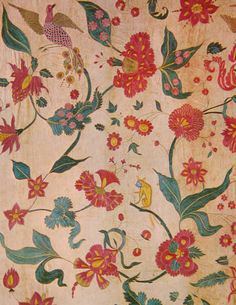
Japanese painting of Portuguese bringing Indian cargo to Japan (1500s AD) – the Mughal Indian Economy
Trade under the Mughals
Under the Mughal Empire, India continued to make a lot of money by trading. Trading ships carried things back and forth. They went west to East Africa and West Asia. And they went east to South-East Asia and China .
The Mughal Empire
The Silk Road
Earlier Indian economy
All our India articles
What was India selling?
Mostly Indian traders sold medicine and pepper and cinnamon and other spices to West Asia. They sold glass beads and cotton cloth to East Africa. In return, they got gold and furs and ivory to take back to India.
Indian doctors and medicine
History of cotton in India
What about cinnamon?
And black pepper?

Cotton cloth from Gujarat, India (1600s AD)
European ships control the ocean
When Portuguese, Dutch, and British ships began to show up in Indian ports in the 1500s, Indian traders sold them cotton cloth and spices too. So the Portuguese traded Indian ivory and ebony to China, and brought back gold, silk, porcelain, and copper. By the 1600s, traders wanted tons of cheap Indian cotton cloth and glass beads to trade to West Africans for enslaved people, and to North American people for furs.
European economy in the 1600s
African clothing and colonization
History of slavery
Madras, Bombay, and Calcutta
Around 1700 AD, though, people in England began to want to buy a lot of Indian cotton cloth too. British ships now carried cotton cloth to England as well as to Africa and Asia. British trading posts in India at Madras, Bombay (modern Mumbai) and Calcutta (modern Kolkata) started to grow into big cities. The Mughal Indian economy suffered.
Tea and salt in India
But British traders began to push Indian people around to make more money for themselves. In the 1820s, the British began to grow a lot of tea in India to sell in England, in order to save money on buying tea from China. Indian people didn’t make money growing tea. In the 1830s, British people put a tax on salt in India, to force Indians to buy British salt instead of making their own.
Where does tea come from?
History of salt and salt taxes
Destroying India’s clothing industry
When the American Civil War started in 1860, the British couldn’t get raw cotton for their mills in England anymore. They forced Indian traders to sell them raw cotton instead of making the cotton into cloth. Millions of Indian spinners and weavers and dyers were put out of work. India, forced to sell cheap raw materials instead of expensive finished manufactured goods, became a much poorer country.
Europe’s economy in the 1800s
European clothing
Industrialization and factories
Cotton and the cotton gin
The American Civil War
Learn by doing: look at printed India-style cloth in a fabric store
More about the Indian economy
Bibliography and further reading about the Indian economy:
Eyewitness India, by Manini Chatterjee (2002). Written for kids.
Ancient India, by Virginia Schomp (2005). Written for teens. Very good for reports.




